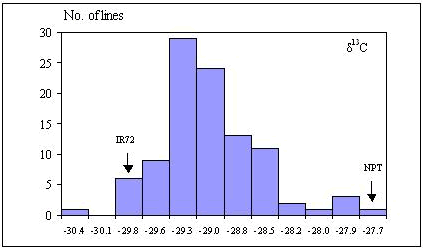by Ma. Rebecca Laza
The positive correlation of carbon isotope discrimination (CID) with grain yield and biomass makes it a desired characteristic for high yield and biomass production in a number of crops including rice. Genotypic variation in CID was reported among rice groups; the japonica types showed lower CID or high stable carbon isotope (δ 13C) values compared with the indica types; suggesting that CID is strongly affected by genetic factor. Identifying morphological and physiological factors, particularly, leaf characters related to the processes that determine genotypic variation in CID is essential in evaluating the value of CID as a criterion either for transpiration efficiency, productivity or both.
Using molecular marker techniques, information on genetic bases for numerous quantitatively inherited traits related to yield and other agronomic and physiological traits of crops has accumulated. In rice, a number of reports focused on genetic factors related to yield and yield components, and related traits. On the other hand, little information is available on the genetic factor that governs physiological functions of leaf traits related to photosynthesis. Quantitative trait loci (QTL) for δ13C in crops such as soybean, cotton, and barley have been reported. In rice, while CID is highly affected by genotypic factor, very little effort has been directed toward understanding its genetic basis and its association with related plant traits and biomass production. Although QTLs for δ13C have been reported, however, their association with other traits related to photosynthesis and productivity under lowland irrigated condition are not known. In addition, the effects of growth stage and plant part on QTL for δ13C have not been examined.
 |
| Figure: Phenotypic distribution of δ13C of top leaves at mid-growth stage of RILs grown under irrigated lowland conditions in 2004. Arrows indicate values of the parents, IR69093-41-3-2 (NPT) and IR72. |
In this study, we employed quantitative trait locus (QTL) analysis to analyze the genetics of δ13C,and other related leaf traits using 101 recombinant inbred lines (RILs) derived from a cross of IR72 (indica) and IR69093-41-3-2 (NPT) grown under flooded conditions for 4 years. We also examined the genetic and phenotypic associations of δ13C with yield, yield components, and biomass productivity.
The phenotypic distribution of leaf δ13C values in 2004 showed that all traits were nearly normally distributed (Figure), having values of skewness and kurtosis of 13C values between parents and only 1% of RILs outperformed the parents. The study revealed the overall feature of the genetic basis for δ13C where we found several QTLs controlling this trait. Putative QTLs for δ13C were identified on chromosomes 2, 4, 9, and 12 across plant parts, stages, and years. Differential expression of QTL for δ13C among stages suggests that each QTL had different functions by stages. Grain δ13C values were negatively correlated with harvest index and grain yield indicating association of δ13C from the carbon assimilated at late growth stages with productivity. However, this genetic association could not be clarified due to the absence of co-located QTLs. Further study is underway to obtain more physiological and morphological information that would be useful in elucidating the genetic associations found in this study, in particular, δ13C and stomatal conductance and their associations with biomass and yield.
Keywords: Rice, QTL, carbon isotope discrimination, grain yield
__________
Dr. Rebecca Laza is currently affiliated with the National Institute of Crop Science in Tsukuba City, Ibaraki, Japan. She is specializing on crop eco-physiology and morphology. She is also affiliated with the International Rice Research Institute back in the Philippines.
NOTE: This abstract also appears in ISKO jointly published by AFSJ, FAST, and STACJ.